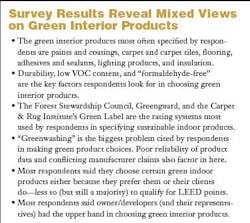How and why AEC professionals choose green interior products
Respondents to our survey had no trouble taking off the gloves when asked to voice their opinions on sustainable interior products and green building. “I first thought the effort to build green was a terrific idea, but it has become a mockery,” said one. “Green certified products do not have anywhere near the level of quality and durability of their ‘normal’ counterparts.” Said another, “Many products have not been in the market to be time-tested.”
“Many claims are not sustainable,” said a respondent. “They do not take into account life cycle assessment or embodied energy.” Said another, “The understanding is that green products have a higher upfront cost but will pay off in the long run. However, the product data does not always properly illustrate this principle.” Another stated, “Clients are still concerned about spending more money on green products.” As for “green hype,” a respondent noted, “That’s the basic difficulty—separating truth from fiction.”
A contractor stated, “Our primary use of ‘green’ is to meet the owner requirements for LEED certification. Green still equals added cost, so competitive requirements mandate that we minimize use [of green products] to remain competitive.” Another respondent said, “There’s a lot of greenwashing for things that don’t ever see a suitable return. Higher prices are not a good thing in this economy.”
Others saw the positive in green interior products. “With what I have experienced thus far, the indoor air quality that evolves from the use of low-VOC and green products produces a more healthy workplace,” said one respondent. Said another, “As more owners, occupants, and the public become knowledgeable about the subject, the demand will increase for truly green products.” Yet another said, “Manufacturers are getting better at documenting their products. Many more products to choose from.”
Still, some said they felt overwhelmed. “Multiple industry standards for green products confuse the issue,” said one. “Too much emphasis on marketing green. What ever happened to good products at a good price?” said another.
“[I] wish there were more people in the industry who were truly interested in sustainable design rather than getting LEED points,” said one wishful thinker. “I have had LEED consultants actually take out sustainable design requirements from a project because they wouldn’t get LEED credit!” Said another, “We just need to get back to basic quality design and construction.” Yet another said, “Performance is more important than ‘green’ qualities.”
One respondent summarized many of these concerns: “I’m all for going green, but not at the expense of quality and durability, and I want to know the claims, considering all the impacts of manufacturing, transporting, etc. If it takes twice as much paint, then the manufacturing costs and transportation costs are doubled, as well as the VOCs. Is that factored into the calculations when trying to see how green a product really is?”
